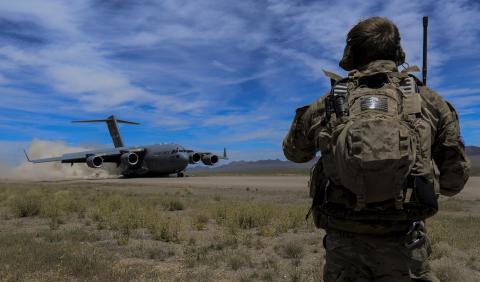Joint, combined amphibious operations constitute the most important and consequential novelty in the art of war. It involves coordinating air, land, sea (surface and subsurface) combat and logistic forces to achieve a significant advantage over an enemy force for a limited time and at a specified location. Its locus is dictated by, among other things, topography, hydrography, tides, weather, and the enemy disposition. Modern technological weapons enable the power of the defense to transition notions of anti-access/anti-denial (A2AD) penetration. The effect of an A2/AD defense prevents the lodgment on hostile shores for subsequent offensive operations. Currently, there is no historic precedent for modern large scale landings against current enemy A2AD layered defensive systems. Although numerous overseas expeditions are recorded in history, most successful landings were conducted on practically undefended shores.
In the A2AD defensive system of our enemies, amphibious warfare poses challenging questions, including whether land forces can be provided with:
1. Combined joint fires superior to the defender; and
2. Adequate force protection during their ship-to-shore and initial shore movements.
Through joint force entry operations, landing operations cannot be conducted unless strategic conditions are established. Facets of land and naval tactics have to adapt to the difficulties of ship-to-shore operations.
What are the strategic conditions of amphibious operations?
- Absolute command of the seas. Annihilating the enemy’s naval power or inhibiting their ability to penetrate the attacker’s naval screen:
- guarantees safe passage of the transports, cargoes and landing craft;
- enables the operations of small and specialized naval capabilities to remove minefields and obstructions; and
- permits supporting elements of the advanced and pre-landing force.
- Air mastery. Significantly degrading the enemy’s air force ensures they are unable to defeat our air, land, or naval power. Furthermore, these conditions increase the tyranny of distance from the fleet, the landing craft, transports, and supply vessels, and the beachhead.
- Exercise of air mastery. Our aviation assets support the ground and naval forces scheme of maneuver by striking high-value targets. The most important mission of aviation assets is the strategic isolation of the battlespace. Successful shaping operations support the concentration of the main effort towards the beachhead and exploitation of the landing.
- Element of surprise. Even under favorable conditions, landing operations are difficult without surprise. The main objective is avoiding the enemy’s main forces. Attaining this outcome requires a joint force unity of effort. While maintaining effective reconnaissance over the enemy’s positions, the enemy must be prevented from obtaining information about location, size, and composition of the amphibious forces, their movements, time and direction of approach. Diversionary movements and unfavorable weather are among usual deception methods.
- Synchronization. The most difficult aspect of landing operations is coordinating a tactically sound timetable, which provides an effective sequence in the attack, the strict adherence to the timely synchronization in spite of resistance and weather, and mutual support and cooperation with maritime escorts and the air force.
- Speed. Without speed, strong counterattacks cannot be prevented. Inadequate speed may lead to the collapse of the landing. To achieve the required speed, swift transitions are necessary for sea-, para- and air-mobile inserted troops between the following tasks:
- initial beach combats;
- build/repair airstrips and special loading, as required by the tactical plan;
- early seizure of port facilities enable quick harbor repair and the concentration of logistical support;
- troops transition ashore in sufficient quantity and launch an offensive before the enemy reforms and prevents exploitation.
These are lessons learned in a series of landing operations since 1942. Guadalcanal (1942) displayed the importance of sea and air mastery. North Africa (1942) taught the necessity of speed, and Sicily (1943) the value of exploitation. Salerno (1943) underscored the consequences of a lack of surprise, the function of strategic bombing, the tactical possibilities of aviation and the capabilities of airmobile reinforcements. In Anzio (1944), we learned that not exploiting a gap from an initial lodgment may not be detrimental to the offensive campaign. In addition, supporting enduring combined arms effects through the use of naval gunfire and air power provides a complex logistical sustainment problem. The importance of isolating the battlefield and rapid exploitation were forcefully emphasized. Tarawa (1943) and Kwajalein (1944) modified our concepts about the volume of fire necessary to neutralize strong coastal defenses.
Amphibious warfare forms an integral part of land war against potential enemies. Amphibious warfare facilitates the application of the basic tactical rule that the enemy is best attrited by attacks against his flanks or rear. Time and again mastery of the sea permitted victors to out maneuver and encircle their enemies, while it prevented enemy forces from mutually supporting each other. Naval power-concentrated in fires, joint service cooperation, and tactical cooperation between the surface, subsurface, air and auxiliary arms of the Navy, and the Air Force enable our forces penetration of littoral defenses.
An amphibious force of modern capability, operating from the sea and equipped with aviation is free from dependence on airfields, beaches, ports, and land bases. The use of land-based forces is an irrevocable step because the commitment is definite and its withdrawal difficult. A self-sustained amphibious force is the primary capability enabling joint force entry because of its flexibility, reliability, and unity of purpose. Naval presence in the South Pacific transmits the desired strategic message, militarily as well as diplomatically. The multifaceted projection capabilities of a balanced naval force of air, surface, subsurface, and amphibious elements demonstrate a range of diplomatic signaling and crisis containment to on-scene military action.




